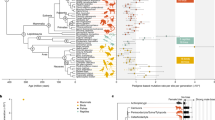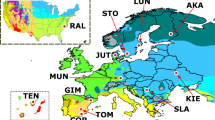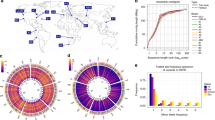Abstract
Analysis of variation at microsatellite DNA loci is widely used in studies of parentage1, linkage2 and evolutionary history3–5. The utility of microsatel I ites is primarily due to high levels of allelic diversity, believed to reflect mutation rates orders of magnitude higher than base pair substitutions at single-copy genes. For humans6–14, mice15–16, rats17 and pigs18, microsatellite mutation rates have been estimated at 10−3–10−5. However, a recent study comparing microsatellite variation in humans with non-human primates suggests that microsatellite mutation rates may vary considerably across taxa19–20. We measured mutation rates of 24 microsatellite loci in mutation accumulation lines of Drosophila melanogaster. Surprisingly, only a single mutation was detected after screening 157,680 allele-generations, yielding an estimated average mutation rate per locus of 6.3 × 10−6, a mutation rate considerably lower than reported for various mammals. We propose that the comparatively low mutation rate is primarily a function of short microsatellite repeat lengths in the D. melanogaster genome.
This is a preview of subscription content, access via your institution
Access options
Subscribe to this journal
Receive 12 print issues and online access
$209.00 per year
only $17.42 per issue
Buy this article
- Purchase on Springer Link
- Instant access to full article PDF
Prices may be subject to local taxes which are calculated during checkout
Similar content being viewed by others
References
Queller, D.C., Strassmann, J.E. & Hughes, C.R. Microsatellites and kinship. Trends Ecol. Evol. 8, 285–288 (1993).
Hearn, C.M., Ghosh, S. & Todd, J.A. Microsatellite for linkage analysis of genetic traits. Trends Genet. 8, 288–294 (1992).
Goldstein, D.B., Linares, A.R., Cavalli-Sforza, L.L. & Feldman, M.W. Genetic absolute dating based on microsatellites and the origin of modern humans. Proc. Natl. Acad. Sci. USA 92, 6723–6727 (1995).
Roy, M.S., Geffen, E., Smith, D., Ostrander, E.A. & Wayne, R.K. Patterns of differentiation and hybridization in North American wolf like canids, revealed by analysis of microsatellite loci. Mol. BioL Evol. 11, 553–570 (1994).
Bowcock, A.M. et al. High resolution of human evolutionary trees with polymorphic microsatellites. Nature 368, 455–457 (1994).
Banchs, I. et al. New alleles at microsatellite loci in CEPH families mainly arise from somatic mutations in the lymphoblastoid cell lines. Hum. Mutat. 3, 365–372 (1994).
Edwards, A., Hammond, H.A., Jin, L., Caskey, C.T. & C hakraborty, R. Genetic variation at five trimeric and tetrameric repeat loci in four human population groups. Genomics 12, 241–253 (1992).
Hastbacka, J. et al. Linkage disequilibrium mapping in isolated founder populations: Diastrophic dysplasia in Finland. Nature Genet. 2, 204–211 (1992).
Kwiatowski, D.I. et al. Construction of a GT polymorphism map of human 9q. Genomics 12, 229–240 (1992).
Bowcock, A. et al. Microsatellite polymorphism linkage map of human chromosome 13q. Genomics 15, 376–386 (1993).
Mahtani, M.M. & Willard, H.F. A polymporphic X-linked tetranucleotide repeat locus displaying a high rate of new mutation: implications for mechanisms of mutation at short tandem repeat loci. Hum. Mol. Genet. 2, 431–437 (1993).
Petrukhin, K.E. et al. A microsatellite genetic linkage map of human chromosome 13. Genomics 15, 76–85 (1993).
Straub, R.E. E. et al. A microsatellite genetic linkage map of human chromosome 18. Genomics 15, 48–56 (1993).
Weber, J.L. & Wong, C. Mutation of human short tandem repeats. Hum. Mol. Genet. 2, 1123–1128 (1993).
Deitrich, W. et al. A genetic map of the mouse suitable for typing intraspecific crosses. Genetics 131, 423–447 (1992).
Dallas, J.F. Estimation of microsatellite mutation rates in recombinant inbred strains of mouse. Mamm. Genome 3, 452–456 (1992).
Serikawa, T. et al. Rat gene mapping using PCR-analyzed microsatellites. Genetics 131, 701–721 (1992).
Ellegren, H. Mutation rates at porcine microsatellite loci. Mamm. Genome 6, 376–377 (1995).
Rubensztein, D.C. et al. Microsatellite evolution - evidence for directionality and variation in rate between species. Nature Genet. 10, 337–343 (1995).
Dover, G. Slippery DNA runs on and on and on. Nature Genet. 10, 254–256 (1995).
Goldstein, D.B. & Clark, A.G. Microsatellite variation in North American populations of Drosophila melanogaster. Nucl. Acids Res. 23, 3882–3886 (1995).
England, P.R., Briscoe, D.A. & Frankham, R. Microsatellite polymorphisms in a wild population of Drosophila melanogaster. Genet. Res. Camb. 67, 285–290 (1996).
Kreitman, M. Nucleotide polymorphism at the alcohol dehydrogenase locus of Drosophila melanogaster. Nature 304, 412–417 (1983).
Singh, R.S. Population genetics and evolution of species related to Drosophila melanogaster. Annu. Rev. Genet. 23, 425–453 (1989).
Takahata, N., Satta, Y. & Klein, J. Divergence time and population size in the lineage leading to modern humans. Theor. Pop. Biol. 48, 198–221 (1995).
Strand, M., Prolla, T.A., Liskay, R.M. & Petes, T.D. Destabilization of tracts of simple repetitive DNA in yeast by mutations affecting DNA mismatch repair. Nature 365, 274–275 (1993).
Mackay, T.F.C., Fry, J.D., Lyman, R.F. & Nuzhdin, S.V. Polygenic mutation in Drosophila melanogaster: estimates from response to selection of inbred strains. Genetics 136, 937–951 (1994).
Mackay, T.F.C., Lyman, R.T. & Hill, W.G. Polygenic mutation in Drosophila melanogaster:non-linear divergence among unselected strains. Genetics 139, 849–859 (1995).
Nuzhdin, S.V. & Mackay, T.F.C. Direct determination of retrotransposon transposition rates in Drosophila melanogaster. Genet. Res. Camb. 63, 139–144 (1994).
Chang, H.-J., Shimmin, L.C., Shyue, S.-K., Hewett-Emmet, D. & Li, W.-H. Weak male-driven molecular evolution in rodents. Proc. Natl. Acad. Sci. USA 91, 827–831 (1994).
Lin, H. & Spradling, A.C. Germline stem cell division and egg chamber development in transplanted Drosophila germaria. Dev. Biol. 159, 140–152 (1993).
Mahowald, A.P. & Kambysellis, M. Oogenesis in The Genetics and Biology of Drosophila. 141–225 (Volume 2d. Academic Press, New York, 1980).
Cooper, K.W. Normal spermatogenesis in Drosophila. in The Biology of Drosophila. (ed. Demerec, M.) 1–61 (John Wiley & Sons, Inc. New York, 1950).
Sonnenblick, B.P. The early embryology of Drosophila melanogaster in The Biology of Drosophila. (ed. Demerec, M.) 62–167 (John Wiley & Sons, Inc. New York, 1950).
Weber, J.L. Informativeness of human (dC-dA)n. (dG-dT)n polymorphisms. Genomics 7, 524–530 (1990).
Gloor, G.B. et al. Type I repressers of P element mobility. Genetics 135, 81–95 (1993).
Casella, G. & Berger, R.L. Statistical Inference.(Duxbury Press, Belmont, California 1992).
Author information
Authors and Affiliations
Rights and permissions
About this article
Cite this article
Schug, M., Mackay, T. & Aquadro, C. Low mutation rates of microsatellite loci in Drosophila melanogaster. Nat Genet 15, 99–102 (1997). https://doi.org/10.1038/ng0197-99
Received:
Accepted:
Issue Date:
DOI: https://doi.org/10.1038/ng0197-99
This article is cited by
-
Population genetic dynamics of dengue vectors Aedes aegypti and Aedes albopictus in Sri Lanka: baseline study for designing Wolbachia control method
International Journal of Tropical Insect Science (2021)
-
Predicting Shannon’s information for genes in finite populations: new uses for old equations
Conservation Genetics Resources (2020)
-
Aedes aegypti in the Black Sea: recent introduction or ancient remnant?
Parasites & Vectors (2018)
-
Successful worldwide invasion of the veined rapa whelk, Rapana venosa, despite a dramatic genetic bottleneck
Biological Invasions (2018)
-
Genetic differentiation over a small spatial scale of the sand fly Lutzomyia vexator (Diptera: Psychodidae)
Parasites & Vectors (2016)



